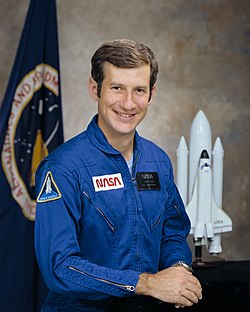Terry Hart | |
|---|---|
 Hart in 1978 | |
| Born | Terry Jonathan Hart October 27, 1946 Pittsburgh, Pennsylvania, U.S. |
| Education | Lehigh University (BS) Massachusetts Institute of Technology (MS) Rutgers University, New Brunswick (MS) |
| Space career | |
| NASA astronaut | |
| Rank | Lieutenant Colonel, USAF |
Time in space | 6d 23h 40m |
| Selection | NASA Group 8 (1978) |
| Missions | STS-41-C |
Mission insignia | |
| Retirement | June 15, 1984 |
Terry Jonathan "T. J." Hart (born October 27, 1946) is an American mechanical and electrical engineer, a retired United States Air Force lieutenant colonel and pilot, and former NASA astronaut. Hart served as a mission specialist on the STS-41-C mission, where tasks included operation of the shuttle Remote Manipulator System (RMS) arm to deploy the Long Duration Exposure Facility (LDEF) and Solar Max satellite.
